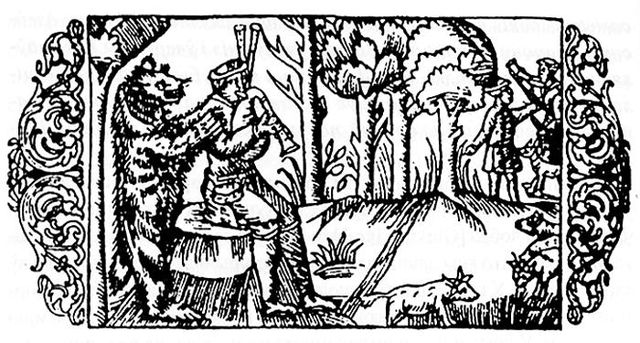Skomorokh
Medieval East Slavic performers From Wikipedia, the free encyclopedia
A skomorokh (Belarusian: скамарох, Ukrainian and Russian: скоморох, Old East Slavic: скоморохъ, Church Slavonic: скоморахъ. Compare with the Old Polish skomrośny, skomroszny[1]) was a medieval East Slavic harlequin or actor, who could also sing, dance, play musical instruments and compose for oral/musical and dramatic performances.
This article should specify the language of its non-English content, using {{langx}}, {{transliteration}} for transliterated languages, and {{IPA}} for phonetic transcriptions, with an appropriate ISO 639 code. Wikipedia's multilingual support templates may also be used. (September 2021) |



Etymology
The etymology of the word is not completely clear.[2] There are hypotheses that the word is derived from the Greek σκώμμαρχος (cf. σκῶμμα, 'joke'); from the Italian scaramuccia ('joker', cf. English scaramouch); from the Arabic masẋara; and many others.[3]
History
Summarize
Perspective
The skomorokhs appeared in Kievan Rus' no later than the mid-11th century, but fresco depictions of skomorokh musicians in the Saint Sophia Cathedral in Kyiv (Ukraine) date to the 11th century.[3]
The Primary Chronicle on skomorokhs concurs with the period. The monk chronicler denounced them as devil servants. Furthermore, the Eastern Orthodox Church often railed against them and other elements of popular culture as being irreverent, detracting from the worship of God or being downright diabolical. For example, Theodosius of Kiev, one of the co-founders of the Caves Monastery in the 11th century, called the skomorokhs "evils to be shunned by good Christians".[4] Their art was related and addressed to the common people and usually opposed the ruling groups. They were considered not just useless but even ideologically detrimental and dangerous by both the feudalists and the clergy.
They were persecuted in the years of the Mongol yoke, when the church strenuously propagated ascetic living. Their art reached its peak in the 15th to the 17th centuries. Their repertoire included mock songs, dramatic and satirical sketches, called глумы (glumy) in Russian (глуми in Ukrainian), performed in masks and skomorokh dresses to the sounds of domra, balalaika, gudok, bagpipes or buben (a kind of tambourine). The appearance of Russian puppet theatre was directly associated with skomorokh performances.[3]
Skomorokhs performed in the streets and city squares, engaging with the spectators to draw them into their play. Usually, the main character of the skomorokh performance was a fun-loving saucy muzhik (мужик in Ukrainian) of comic simplicity. In the 16th and 17th centuries, skomorokhs would sometimes combine their efforts and perform in a vataga (ватага in Ukrainian, big crowd), numbering 70 to 100 people. The skomorokhs were often persecuted by the Russian Orthodox Church and civilian authorities.
In 1648 and 1657, Tsar Alexei Mikhailovich issued ukases banning skomorokh art as blasphemous, their inventory was destroyed, skomorokhs fell into captivity, were pursued but actors would still occasionally perform during popular celebrations.[5][6][7] In the 18th century, skomorokh art gradually died away; passing on some of its traditions to the balagans (балаган in Ukrainian) and rayoks (райок in Ukrainian).[3]
The role of the skomorokhi in the preservation and dissemination of folklore was closely linked with their important contribution to the development of secular music, first in Kievan Rus’ and later in Muscovite Russia. Before the introduction of Christianity in the late tenth century, Kievan music was characterized primarily by ritualistic songs of worship, ceremonial (i.e., wedding, funeral) songs, and seasonal songs such as koliadky and haivky. With Byzantine Christianity came Byzantine chant and a vigorous attempt to suppress native music because of its close identification with paganism. This attempted suppression was only partially successful, because it was mainly aimed at the more populous urban centers and left the remote rural areas with their flourishing folk music relatively untouched.[8]
In popular culture
A skomorokh is present in the first episode of Andrei Tarkovsky's film Andrei Rublev (1966). Seeking shelter from rain, the main characters enter a barn where a group of villagers are entertained by a skomorokh (played by Rolan Bykov). The skomorokh earns a living with his scathing and obscene social commentary, and by making fun of the boyars and the Church.[citation needed]
See also
References
External links
Wikiwand - on
Seamless Wikipedia browsing. On steroids.
